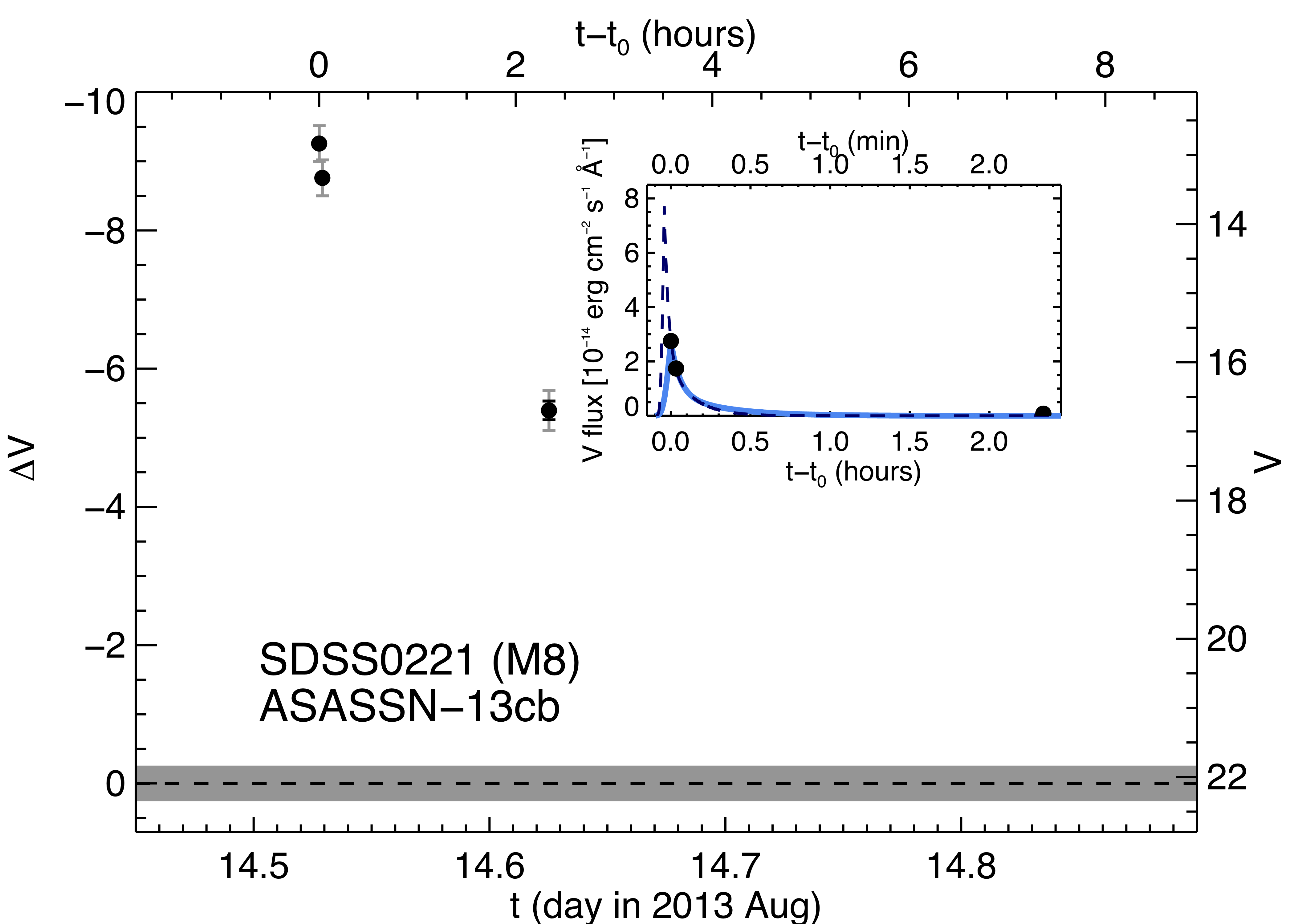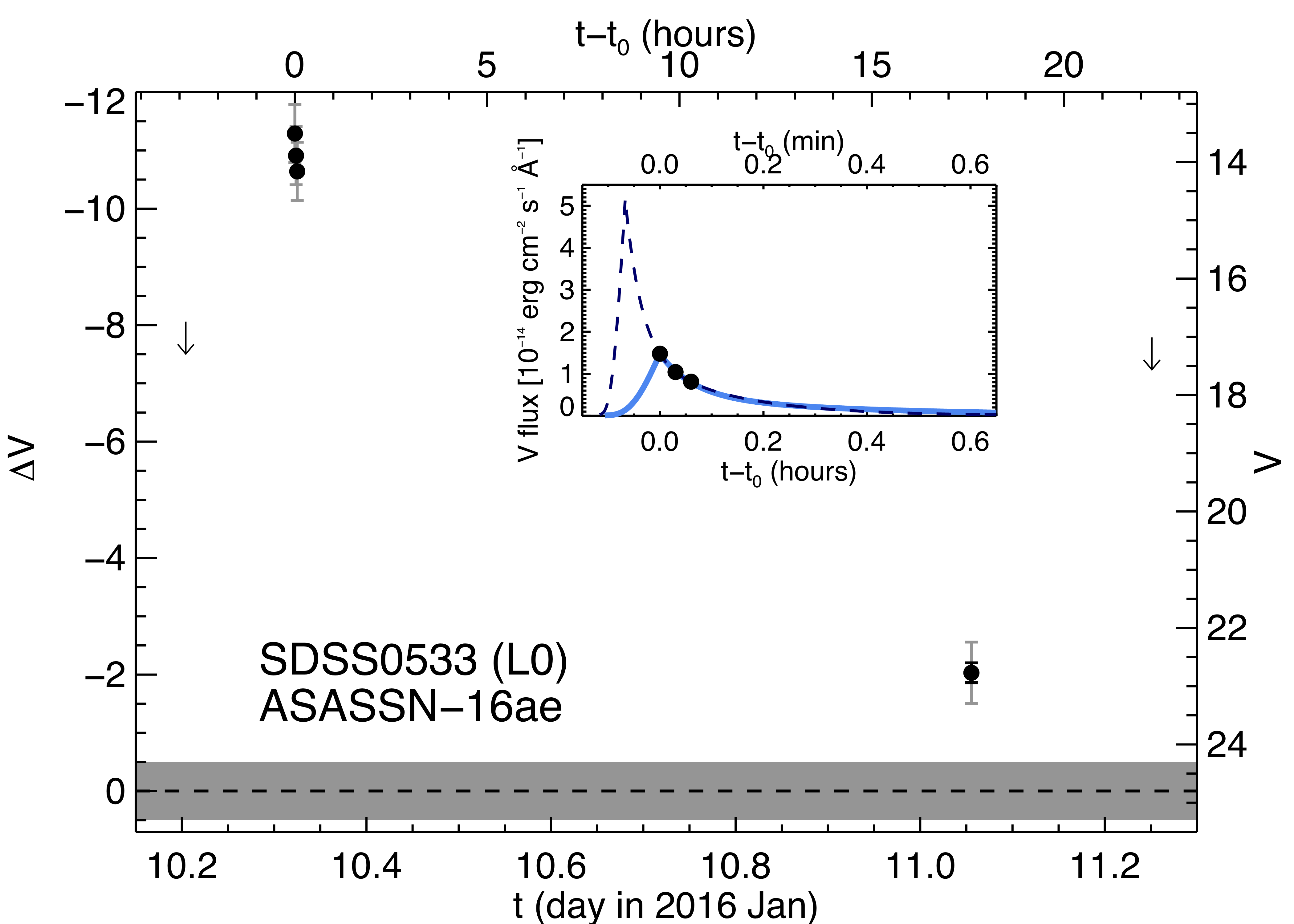The All Sky Automated Survey for Supernovae (ASAS-AN) scans the sky once a night, looking for supernovae. The survey has also caught some of the largest stellar flares. ASAS-SN is particularly sensitive to dramatic transients, and so easily observes some of the largest flares on the smallest stars. These are particularly strong because of the contrast effect - the stellar atmosphere is particularly faint and cool at the wavelengths where the flare emission is hot and bright.
Before more modern time domain surveys, the only flares observed on these small stars were shown in Hα and other atomic lines without a strong white-light component. ASAS-SN observed two particularly large white-light flares on ultracool dwarfs with spectral types M8 and L0, ushering in an era where ultracool dwarf flares are known to be relatively common.
V magnitude as a function of time for the two most dramatic flares found in ASAS-SN, ASASSN-13cb and ASASSN-16ae. At their peak detected brightness, the flares increased total light received from the star by 9 magnitudes (over 3000 times) and 11 magnitudes (over 40000 times) respectively. The ASAS-SN detections are the filled circles, with the quiescent brightness shown as the dashed line. In the inset figure, the flare detections are shown in units of flux, with possible representative flares models shown.
Interpreting the ASAS-SN data on flares is a challenge. The observations of each stellar flare only include of a few data points taken at some unknown time during the flare event. I designed a method for estimating the energy of these flares based on the sparse cadence data. A handful of detected points can place strong lower limits on the total flare energy because it is not physically possible for the heated plasma that generates the emission to cool instantaneously, so the flare must include a decay phase. I used the Davenport et al. empirical flare model to model the rise and decay phases of these flares, making assuming the ASAS-SN observations occurred near the flare peak.
The energies for the first two flares characterized were consistent with dramatic events - 1034 erg flares, comparable to the strongest flares on earlier M dwarfs and thousands of times stronger than those detected on the Sun. We then examined the fifty largest flares in the first four years of the survey (2013-2016), finding an expected correlation between Hα activity and confirming the potential of ASAS-SN to find some of the strongest and most fascinating flares.
Work with ASAS-SN flares continues! I am part of the team working with Romy Rodriguz, an Ohio State Graduate Student, to look at flares on a sample of nearby M dwarfs. As the ASAS-SN survey continues to expand, we expect many more dramatic flares and may be able to calculate the rate of the rarest, largest stellar flares. Additionally, the techniques developed to analyze sparse flares in this bright transient survey can be adapted to understand the flares found in future large sparse cadence surveys, like ZTF and LSST.
-
Flares Big and Small: a K2 and TESS View of ASAS-SN Superflares
Jesse Zeldes, Jason T. Hinkle, Benjamin J. Shappee, Ellis A. Avallone, Sarah J. Schmidt, Jennifer L. van Saders, Zachary Way, Christopher S. Kochanek, and Thomas W. -S. Holoien
arXiv e-prints, Sep 2021
We investigate the flare-frequency distributions of 5 M-dwarfs that experienced superflares with energies in excess of 1033 erg detected by ASAS-SN. We use K2 and TESS short-cadence observations along with archival ASAS-SN data to categorise the flaring behaviour of these stars across a range of flare energies. We were able to extract a rotation period for 4 of the stars. They were all fast rotators ( Prot≤6d ), implying relative youth. We find that the flare-frequency distributions for each of the stars are well fit by a power-law, with slopes between α=1.22 and α=1.82 . These slopes are significantly flatter than those of fast-rotating M-dwarfs not selected for their superflaring activity, corresponding to an increased number of high energy flares. Despite our specific selection of superflaring stars with shallow flare-rate distributions and more power in higher-energy flares, we find that the implied UV flux is insufficient to deplete the ozone of earth-sized planets in the habitable zone around these stars. Furthermore, we find that the flares detected on the stars in our sample are insufficient to produce the UV flux needed to fuel abiogenetic processes. These results imply that given available models, even M-dwarfs selected for extreme flaring properties may have insufficient UV emission from flares to impact exolife on earth-sized planets in the habitable zones around M-dwarfs.
-
A Catalog of M-dwarf Flares with ASAS-SN
Romy Rodrı́guez Martı́nez, Laura A. Lopez, Benjamin J. Shappee, Sarah J. Schmidt, Tharindu Jayasinghe, Christopher S. Kochanek, Katie Auchettl, and Thomas W. -S. Holoien
ApJ, Apr 2020
We analyzed the light curves of 1376 early-to-late, nearby M dwarfs to
search for white-light flares using photometry from the All-Sky
Automated Survey for Supernovae. We identified 480 M dwarfs with
at least one potential flare employing a simple statistical
algorithm that searches for sudden increases in V-band flux.
After more detailed evaluation, we identified 62 individual
flares on 62 stars. The event amplitudes range from 0.12 <
ΔV<2.04 mag. Using classical flare
models, we place lower limits on the flare energies and obtain
V-band energies spanning 2.0x1030
≲ EV ≲
6.9x1035 erg. The fraction of flaring stars
increases with spectral type, and most flaring stars show
moderate to strong Hα emission.
Additionally, we find that 14 of the 62 flaring stars are
rotational variables, and they have shorter rotation periods and
stronger Hα emission than nonflaring
rotational variable M dwarfs.
-
The Largest M Dwarf Flares from ASAS-SN
Sarah J. Schmidt, Benjamin J. Shappee, Jennifer L. van Saders, K. Z. Stanek, Jonathan S. Brown, C. S. Kochanek, Subo Dong, Maria R. Drout, Stephan Frank, T. W. -S. Holoien, and
6 more authors
ApJ, May 2019
The All-sky Automated Survey for Supernovae (ASAS-SN) is the only project in existence to scan the entire sky in optical light approximately every day, reaching a depth of g ∼ 18 mag. Over the course of its first 4 yr of transient alerts (2013─2016), ASAS-SN observed 53 events classified as likely M dwarf flares. We present follow-up photometry and spectroscopy of all 53 candidates, confirming flare events on 47 M dwarfs, one K dwarf, and one L dwarf. The remaining four objects include a previously identified T Tauri star, a young star with outbursts, and two objects too faint to confirm. A detailed examination of the 49 flare star light curves revealed an additional six flares on five stars, resulting in a total of 55 flares on 49 objects ranging in V-band contrast from ∆V = −1 to −10.2 mag. Using an empirical flare model to estimate the unobserved portions of the flare light curve, we obtain lower limits on the V-band energy emitted during each flare, spanning log(EV/erg)=32─35, which are among the most energetic flares detected on M dwarfs. The ASAS-SN M dwarf flare stars show a higher fraction of Hα emission, as well as stronger Hα emission, compared to M dwarfs selected without reference to activity, consistent with belonging to a population of more magnetically active stars. We also examined the distribution of tangential velocities, finding that the ASAS-SN flaring M dwarfs are likely to be members of the thin disk and are neither particularly young nor old.
-
ASASSN-16ae: A Powerful White-light Flare on an Early-L Dwarf
Sarah J. Schmidt, Benjamin J. Shappee, Jonathan Gagné, K. Z. Stanek, José L. Prieto, Thomas W. -S. Holoien, C. S. Kochanek, Laura Chomiuk, Subo Dong, Mark Seibert, and
1 more author
ApJL, Sep 2016
We report the discovery and classification of SDSS J053341.43+001434.1 (SDSS0533), an early-L dwarf first discovered during a powerful ∆V < -11 magnitude flare observed as part of the ASAS-SN survey. Optical and infrared spectroscopy indicate a spectral type of L0 with strong Hα emission and a blue NIR spectral slope. Combining the photometric distance, proper motion, and radial velocity of SDSS0533 yields three-dimensional velocities of (U, V, W) = (14±13, -35±14, -94±22) km s-1, indicating that it is most likely part of the thick disk population and probably old. The three detections of SDSS0533 obtained during the flare are consistent with a total V-band flare energy of at least 4.9 × 1033 erg (corresponding to a total thermal energy of at least E tot > 3.7 × 1034 erg), placing it among the strongest detected M dwarf flares. The presence of this powerful flare on an old L0 dwarf may indicate that stellar-type magnetic activity persists down to the end of the main sequence and on older ML transition dwarfs.
-
Characterizing a Dramatic ∆V~-9 Flare on an Ultracool Dwarf Found by the ASAS-SN Survey
Sarah J. Schmidt, Jose L. Prieto, K. Z. Stanek, Benjamin J. Shappee, Nidia Morrell, Daniella C. Bardalez Gagliuffi, C. S. Kochanek, J. Jencson, T. W. -S. Holoien, U. Basu, and
12 more authors
ApJL, Feb 2014
We analyze a ∆V~-9 magnitude flare on the newly identified M8 dwarf SDSS J022116.84+194020.4 (hereafter SDSSJ0221) detected as part of the All-Sky Automated Survey for Supernovae. Using infrared and optical spectra, we confirm that SDSSJ0221 is a relatively nearby (d~76 pc) M8 dwarf with strong quiescent Hα emission. Based on kinematics and the absence of features consistent with low-gravity (young) ultracool dwarfs, we place a lower limit of 200 Myr on the age of SDSSJ0221. When modeled with a simple, classical flare light curve, this flare is consistent with a total U-band flare energy EU~1034 erg, confirming that the most dramatic flares are not limited to warmer, more massive stars. Scaled to include a rough estimate of the emission line contribution to the V band, we estimate a blackbody filling factor of ~10%-30% during the flare peak and ~0.5%-1.6% during the flare decay phase. These filling factors correspond to flare areas that are an order of magnitude larger than those measured for most mid-M dwarf flares. This publication is partially based on observations obtained with the Apache Point Observatory 3.5 m telescope, which is owned and operated by the Astrophysical Research Consortium.

